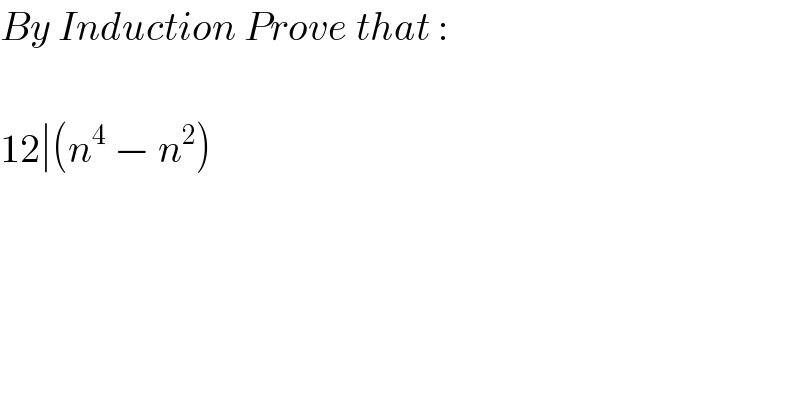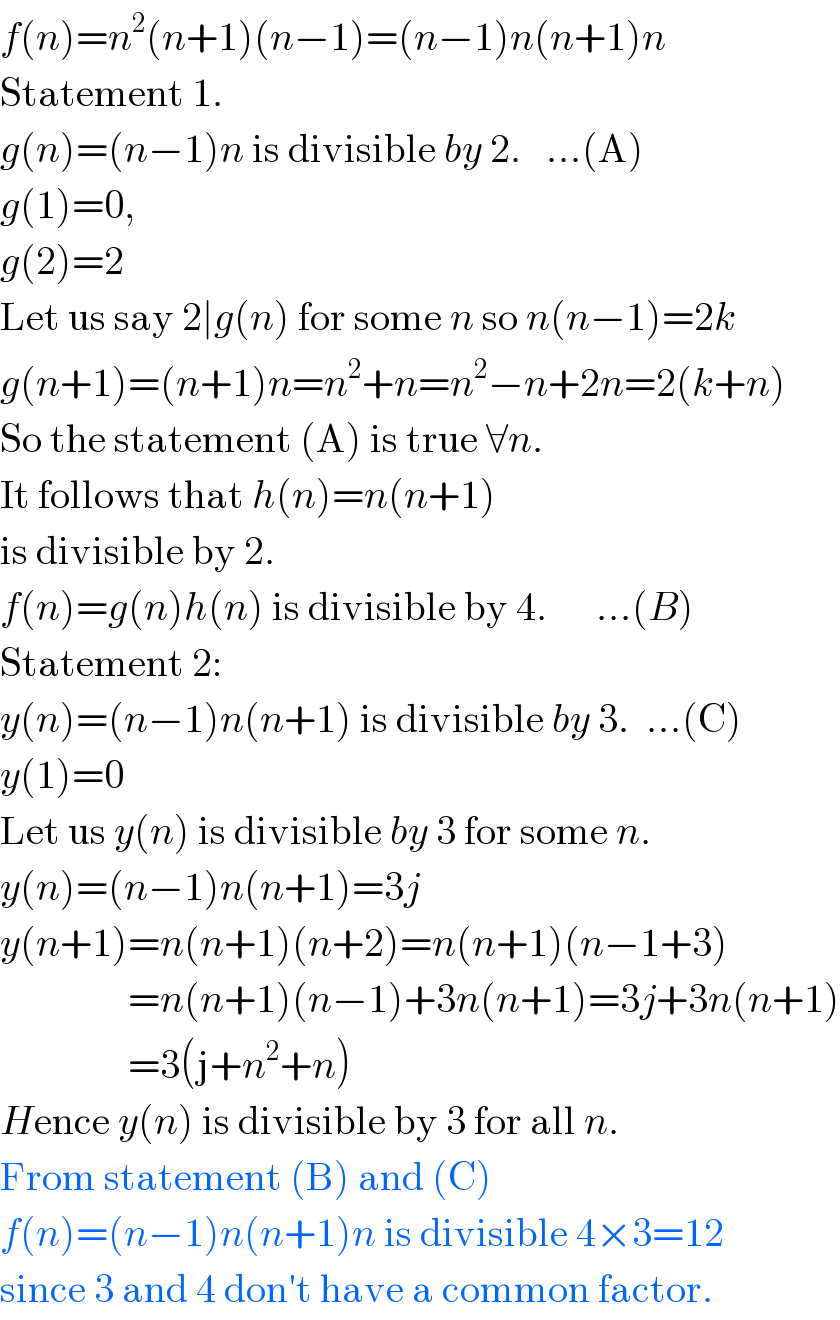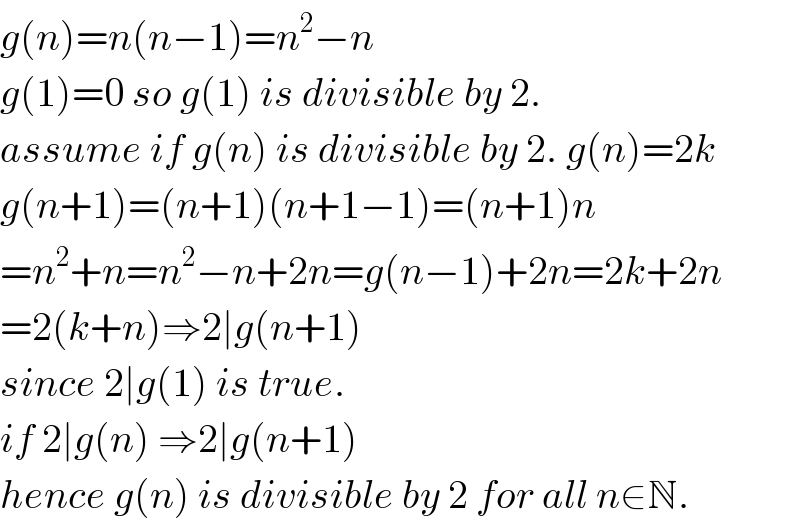
Question Number 2857 by Syaka last updated on 29/Nov/15

$${By}\:{Induction}\:{Prove}\:{that}\:: \\ $$$$ \\ $$$$\mathrm{12}\mid\left({n}^{\mathrm{4}} \:−\:{n}^{\mathrm{2}} \right) \\ $$
Commented by Filup last updated on 29/Nov/15

$$\mathrm{What}\:\mathrm{does}\:\mid\:\mathrm{mean}? \\ $$
Commented by prakash jain last updated on 29/Nov/15

$${n}^{\mathrm{4}} −{n}^{\mathrm{2}} \:\mathrm{is}\:\mathrm{divisible}\:\mathrm{by}\:\mathrm{12}. \\ $$
Commented by Syaka last updated on 29/Nov/15

$${yes},\:{Sir} \\ $$
Answered by prakash jain last updated on 29/Nov/15

$${f}\left({n}\right)={n}^{\mathrm{2}} \left({n}+\mathrm{1}\right)\left({n}−\mathrm{1}\right)=\left({n}−\mathrm{1}\right){n}\left({n}+\mathrm{1}\right){n} \\ $$$$\mathrm{Statement}\:\mathrm{1}. \\ $$$${g}\left({n}\right)=\left({n}−\mathrm{1}\right){n}\:\mathrm{is}\:\mathrm{divisible}\:{by}\:\mathrm{2}.\:\:\:...\left(\mathrm{A}\right) \\ $$$${g}\left(\mathrm{1}\right)=\mathrm{0}, \\ $$$${g}\left(\mathrm{2}\right)=\mathrm{2} \\ $$$$\mathrm{Let}\:\mathrm{us}\:\mathrm{say}\:\mathrm{2}\mid{g}\left({n}\right)\:\mathrm{for}\:\mathrm{some}\:{n}\:\mathrm{so}\:{n}\left({n}−\mathrm{1}\right)=\mathrm{2}{k} \\ $$$${g}\left({n}+\mathrm{1}\right)=\left({n}+\mathrm{1}\right){n}={n}^{\mathrm{2}} +{n}={n}^{\mathrm{2}} −{n}+\mathrm{2}{n}=\mathrm{2}\left({k}+{n}\right) \\ $$$$\mathrm{So}\:\mathrm{the}\:\mathrm{statement}\:\left(\mathrm{A}\right)\:\mathrm{is}\:\mathrm{true}\:\forall{n}. \\ $$$$\mathrm{It}\:\mathrm{follows}\:\mathrm{that}\:{h}\left({n}\right)={n}\left({n}+\mathrm{1}\right)\: \\ $$$$\mathrm{is}\:\mathrm{divisible}\:\mathrm{by}\:\mathrm{2}.\:\:\:\: \\ $$$${f}\left({n}\right)={g}\left({n}\right){h}\left({n}\right)\:\mathrm{is}\:\mathrm{divisible}\:\mathrm{by}\:\mathrm{4}.\:\:\:\:\:\:...\left({B}\right) \\ $$$$\mathrm{Statement}\:\mathrm{2}: \\ $$$${y}\left({n}\right)=\left({n}−\mathrm{1}\right){n}\left({n}+\mathrm{1}\right)\:\mathrm{is}\:\mathrm{divisible}\:{by}\:\mathrm{3}.\:\:...\left(\mathrm{C}\right) \\ $$$${y}\left(\mathrm{1}\right)=\mathrm{0} \\ $$$$\mathrm{Let}\:\mathrm{us}\:{y}\left({n}\right)\:\mathrm{is}\:\mathrm{divisible}\:{by}\:\mathrm{3}\:\mathrm{for}\:\mathrm{some}\:{n}. \\ $$$${y}\left({n}\right)=\left({n}−\mathrm{1}\right){n}\left({n}+\mathrm{1}\right)=\mathrm{3}{j} \\ $$$${y}\left({n}+\mathrm{1}\right)={n}\left({n}+\mathrm{1}\right)\left({n}+\mathrm{2}\right)={n}\left({n}+\mathrm{1}\right)\left({n}−\mathrm{1}+\mathrm{3}\right) \\ $$$$\:\:\:\:\:\:\:\:\:\:\:\:\:\:\:\:={n}\left({n}+\mathrm{1}\right)\left({n}−\mathrm{1}\right)+\mathrm{3}{n}\left({n}+\mathrm{1}\right)=\mathrm{3}{j}+\mathrm{3}{n}\left({n}+\mathrm{1}\right) \\ $$$$\:\:\:\:\:\:\:\:\:\:\:\:\:\:\:\:=\mathrm{3}\left(\mathrm{j}+{n}^{\mathrm{2}} +{n}\right) \\ $$$${H}\mathrm{ence}\:{y}\left({n}\right)\:\mathrm{is}\:\mathrm{divisible}\:\mathrm{by}\:\mathrm{3}\:\mathrm{for}\:\mathrm{all}\:{n}. \\ $$$$\mathrm{From}\:\mathrm{statement}\:\left(\mathrm{B}\right)\:\mathrm{and}\:\left(\mathrm{C}\right) \\ $$$${f}\left({n}\right)=\left({n}−\mathrm{1}\right){n}\left({n}+\mathrm{1}\right){n}\:\mathrm{is}\:\mathrm{divisible}\:\mathrm{4}×\mathrm{3}=\mathrm{12} \\ $$$$\mathrm{since}\:\mathrm{3}\:\mathrm{and}\:\mathrm{4}\:\mathrm{don}'\mathrm{t}\:\mathrm{have}\:\mathrm{a}\:\mathrm{common}\:\mathrm{factor}. \\ $$
Commented by RasheedAhmad last updated on 29/Nov/15

$$\mathrm{6}{th}\:{line}:{n}\left({n}−\mathrm{1}\right)=\mathrm{2}{k} \\ $$$$\mathrm{7}{th}\:{line}:{n}^{\mathrm{2}} −{n}+\mathrm{2}{n}=\mathrm{2}\left({k}+\mathrm{1}\right)? \\ $$$${n}^{\mathrm{2}} −{n}+\mathrm{2}{n}=\mathrm{2}{k}+\mathrm{2}{n}=\mathrm{2}\left({k}+{n}\right) \\ $$
Commented by prakash jain last updated on 29/Nov/15

$$\mathrm{Thanks}\:\mathrm{Rasheed}. \\ $$$$\mathrm{I}\:\mathrm{have}\:\mathrm{corrected}\:\mathrm{the}\:\mathrm{mistake}. \\ $$
Commented by Rasheed Soomro last updated on 29/Nov/15
![g(n+1)=(n+1)n=n^2 +n=n^2 −n+2n=2(k+n) So the statement (A) is true ∀n. How is 2(k+n) of the type (n−1)n g(n)=(n−1)n g(n+1)=2(k+n) On lhs n+1 indicates that you are seeking result for n+1,but on rhs you reached at 2(k+n) [instead of (n+1^(−) −1)(n+1)] Why So the statement (A) is true ∀n.?](Q2897.png)
$${g}\left({n}+\mathrm{1}\right)=\left({n}+\mathrm{1}\right){n}={n}^{\mathrm{2}} +{n}={n}^{\mathrm{2}} −{n}+\mathrm{2}{n}=\mathrm{2}\left({k}+{n}\right) \\ $$$$\mathrm{So}\:\mathrm{the}\:\mathrm{statement}\:\left(\mathrm{A}\right)\:\mathrm{is}\:\mathrm{true}\:\forall{n}. \\ $$$${How}\:{is}\:\mathrm{2}\left({k}+{n}\right)\:{of}\:{the}\:{type}\:\left({n}−\mathrm{1}\right){n} \\ $$$${g}\left({n}\right)=\left({n}−\mathrm{1}\right){n} \\ $$$${g}\left({n}+\mathrm{1}\right)=\mathrm{2}\left({k}+{n}\right) \\ $$$$\mathcal{O}{n}\:{lhs}\:{n}+\mathrm{1}\:{indicates}\:{that}\:{you}\:{are}\:{seeking}\: \\ $$$${result}\:{for}\:{n}+\mathrm{1},{but}\:{on}\:{rhs}\:{you}\:{reached}\:{at}\:\mathrm{2}\left({k}+{n}\right) \\ $$$$\left[{instead}\:{of}\:\left(\overline {{n}+\mathrm{1}}−\mathrm{1}\right)\left({n}+\mathrm{1}\right)\right] \\ $$$${Why}\:\mathrm{So}\:\mathrm{the}\:\mathrm{statement}\:\left(\mathrm{A}\right)\:\mathrm{is}\:\mathrm{true}\:\forall{n}.? \\ $$
Commented by prakash jain last updated on 29/Nov/15

$${g}\left({n}\right)={n}\left({n}−\mathrm{1}\right)={n}^{\mathrm{2}} −{n}\: \\ $$$${g}\left(\mathrm{1}\right)=\mathrm{0}\:{so}\:{g}\left(\mathrm{1}\right)\:{is}\:{divisible}\:{by}\:\mathrm{2}. \\ $$$${assume}\:{if}\:{g}\left({n}\right)\:{is}\:{divisible}\:{by}\:\mathrm{2}.\:{g}\left({n}\right)=\mathrm{2}{k} \\ $$$${g}\left({n}+\mathrm{1}\right)=\left({n}+\mathrm{1}\right)\left({n}+\mathrm{1}−\mathrm{1}\right)=\left({n}+\mathrm{1}\right){n} \\ $$$$={n}^{\mathrm{2}} +{n}={n}^{\mathrm{2}} −{n}+\mathrm{2}{n}={g}\left({n}−\mathrm{1}\right)+\mathrm{2}{n}=\mathrm{2}{k}+\mathrm{2}{n} \\ $$$$=\mathrm{2}\left({k}+{n}\right)\Rightarrow\mathrm{2}\mid{g}\left({n}+\mathrm{1}\right) \\ $$$${since}\:\mathrm{2}\mid{g}\left(\mathrm{1}\right)\:{is}\:{true}. \\ $$$${if}\:\mathrm{2}\mid{g}\left({n}\right)\:\Rightarrow\mathrm{2}\mid{g}\left({n}+\mathrm{1}\right) \\ $$$${hence}\:{g}\left({n}\right)\:{is}\:{divisible}\:{by}\:\mathrm{2}\:{for}\:{all}\:{n}\in\mathbb{N}. \\ $$
Commented by Rasheed Soomro last updated on 30/Nov/15

$$\mathcal{T}\boldsymbol{{h}}^{\boldsymbol{{a}}} \boldsymbol{\mathcal{N}{k}}\mathcal{S}\:\mathcal{S}\boldsymbol{{ir}}!\:\mathcal{I}\:\boldsymbol{{underst}}{oo}\boldsymbol{{d}}\:\boldsymbol{{now}}. \\ $$
Commented by Rasheed Soomro last updated on 30/Nov/15

$$\boldsymbol{\mathcal{EXCELLENT}}\:\boldsymbol{\mathcal{A}{pproach}}! \\ $$
